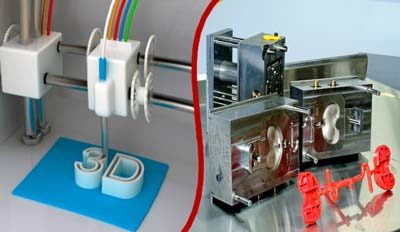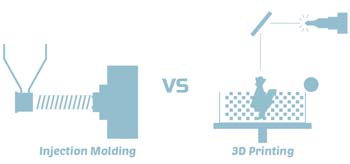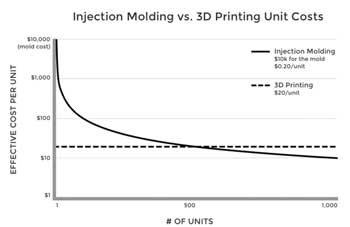
Gone are the days when you had to keep your ideas of visual designs a secret! See your vision come to life with modern technological revolutions like 3D printing and injection molding!
Both of these processes are very popular among creative individuals and professionals to make plastic sculptures. But which one is the best choice for your projects and preferences? Let’s compare 3D printing vs injection molding to see which one turns out to be the better option!
What is 3D Printing?
3D printing is how you can bring two-dimensional objects into life!
It typically transforms a digital image or file into a realistic three-dimensional solid figure. Although plastic is the first choice for most projects, the material can change to ceramics, metals and others according to your individual requirements.
The process of 3D printing is an additive one where successive layers are formed over each other to build the final figure. Each of these layers follows the digital instructions laid out in a programming file. You can either code it yourself or download one from online 3D repositories.
Currently, there is a good number of 3D modeling software tools in the market for you to choose from. If this is a completely new front for you, try out the open-source materials available online first. You don’t even need to install some of them and just work on the projects through an internet browser!
When you are used to those basic methods and principles, you can upgrade the tools for more enhanced experiences. However, this may prove to be quite expensive since the high-end professional 3D modeling software systems cost thousands of dollars each year.
Advantages of 3D Printing
Fast and Simple
3D printing is a fairly simple process to operate and produces good results in a short span of time. Compared to other similar processes like subtractive production, 3D printing gets the job done faster. This is because the steps of prototype designing and testing are quicker here.
For the same reason, you will get more time to tune the testing requirements, design parameters and other specifications to reach the truly best possible iteration of your initial concept. You can finish up a project within hours with 3D printing while it would take days to weeks for other substitute methods.
Easy Accessibility
You don’t need to have any special access or tons of cash lying around to get your hands on a 3D printer. There are many models of this device made by multiple brands available in both online and offline stores. Once you get the hardware in place, you can rely on any compatible software to get started on your 3D voyage!
Prototype Consistency
Since almost everything in this process depends on carefully articulated programs and meticulously calculated algorithms, you can create the exact same structure a hundred times with 3D printers. You don’t have to worry about working with inconsistent bits for your final structure here.
Tangible Testing
With 3D printing, you don’t have to rely on only virtual or digital models to test out a theory! You can create tangible modules for each stage and see how they all fit together in the end. So before preparing the final prototype, you will have plenty of chances to get it right through several physical models.
Flexibility
3D printing allows you more room for creativity and customizations. You can make countless modifications to the same digital mold with this process. It is very easy to tweak a few things here and there, as well as changing one or more integral parts into a completely different shape! So the possibilities are endless with 3D!
Disadvantages of 3D Printing
Materials Restriction
One of the creative drawbacks in 3D printing is that it only works for a limited range of materials. Plastic is the most common choice for this job because of its abundance in markets and flexibility to mold into any shape while melted.
Other popular options include metal, gold and glass but these are not applicable for the DIY or home-based projects. Only big corporations with industrial capabilities can have access to these materials since they are not commercialized yet.
Size Limitations
The 3D printers at present don’t have enough room to build large structures.
Although you may have heard about a boat made entirely with a 3D printer last year, devices of this caliber are not really available to the common people. Only huge successful enterprises can afford to use those largest 3D printers in the world.
For the rest of us, we need to make the best of devices allowing up to 2 feet in size. As a result, all our ideas will not be able to see the light of the day. We will have to pick the ones practical enough for our own 3D printer.
Excess Consumption
Another catch of using 3D printers is that you may see a bump in the energy bills. The Loughborough University published in their 2011 research that these printers use up about 50-100x more energy than others when lasers or heat are involved. Another 2009 study showed similar use of electrical energy in metal 3D printing.
Toxic Emissions
Using 3D printers indoors frequently can lead to the accumulation of toxic elements in that area. A research from 2013 conducted by the Illinois Institute of Technology concluded that these elements can be carcinogenic ultrafine particles and dangerous volatile compounds.
So make sure to use the printers in an open space. If you have to use it in a room, keep the windows and balcony doors open during the process.
High Cost
The devices required for 3D printing come at a pretty high price point. Unless you have a flexible enough budget, going down this road will not be a great idea. Even the cheapest of them will cost a couple hundred dollars while the better models will require a few thousand dollars!
Read More: Why 3D Printing is Bad? Here’s why it could be bad and why it’s GOOD here!
What is Injection Molding?
In injection molding, you insert molten materials into certain molds to make individual parts. These parts can then be used to build up the main structure. You will have a wide range of options when it comes to injection molding materials. The most common choices include metal, thermoplastic, glass and elastomer.
Professionals rely on injection molding machines in their manufacturing process. They help to create as many copies as necessary of the same part without altering even the most trivial features. As a result, they make the mass production stage much more efficient.
Advantages of Injection Molding
Intricate Details
You can use injection molding to create the manufactured parts which require intricate details. These machines deliver the minute details successfully each time regardless of the part’s size. Such reassurance of uniformity and flawless implementation of the required designs make the industrial processes easier.
Strength and Tolerance
The products of injection molding usually have tight tolerances. Although this can vary according to certain design elements like thick walls, it usually comes through as a highly tolerant structure.
Using fillers in the process reduces plastic density and makes the total product even stronger. For all these reasons, industry-standard engineering relies on injection molding.
Creative Freedom
Even though plastic is the most prominent material for injection molding, there are many variations to it. You can combine these types of plastic simultaneously to get the perfect product meeting your requirements.
Besides, injection molding also allows for creating multi-colored parts using pre-colored resins, liquid colors and similar tools.
High Efficiency
Injection molding is one of the most efficient ways to manufacture parts for industrial standard projects. It can deliver a large number of products within very short time periods amounting to just 15 to 120 seconds! The total time taken to form each mold varies according to its material, size and complexity.
Low Labor Cost
Manufacturers can keep the labor costs low since these machines keep on producing the same object a million times automatically. All the worker has to do is complete the initial mold properly and begin the series of iterations. As a result, a company can see huge profits without a high cost per unit.
Disadvantages of Injection Molding
Rubber Waste
In the process of injection molding, a significant amount of the materials like rubber doesn’t get used in the end. It enters the mold cavities from the injection chamber through many feed gates and runners. As a result, much of it stays out of the main product and goes into waste.
High Setup Cost
Although the labor cost is low, it can be expensive to set up the machine. If you want to upgrade the readymade injection molding machine even further, you will have to keep the additional costs in mind. Along with the high expense, the setup can also take a long time, especially with the installation of extra features.
Comparing Injection Molding vs 3D Printing

While they may seem to be producing the same objects, they do differ in certain aspects like complexity, tolerance, speed and similar factors. Let’s see how they fare against each other in all these regards!
Ideal Applications
3D printing is better suited for projects or objects which require high levels of complexity or organic shapes since it involves precise programming. But when it comes to industry-standard engineering and tolerance, injection molding takes the cake.
The professionals use 3D printing extensively for rapid prototyping, dental products, prosthetics and eyewear. Besides, more ambitious projects like enameled pottery, sculptures, clothing, shoes and artificial food have also been successful with this process.
Injection molding, on the other hand, is used for producing automobile parts, mechanical parts, containers, bottles, toys, cellphone cases, wire spools, pocket combs and packaging. Other applications of this process include musical instruments and small pieces of furniture.
Mechanism
These two popular methods of creating plastic structures follow two entirely different paths to reach the end product. 3D printing is about entering carefully calculated digital instructions into the machine, while injection molding enters the molten material into a pre-made mold.
Time
How fast you can get the results through either of these processes depends mostly on the complexity level and size of the particular project. The most complicated structures may take up to a few hours in 3D printing. Injection molding can deliver as fast as just a few seconds in one cycle.
However, the total turnaround time for both methods can take up to weeks. It is usually 8-10 weeks for injection molding and 1-3 weeks for 3D printing. That is because injection molding has more steps like designing the mold tool which takes a lot of time and expense.
Mass Production
Injection molding is the better choice for mass production since its machine can generate the same structure in millions of copies. As a result, once the mold is finalized, you can just turn on the machine and let it go on until your goal is achieved.

Image Credit: https://blog.voodoomfg.com/2017/02/02/high-volume-3d-printing-vs-injection-molding/
Flexibility
It is easier to fix a mistake in 3D printing than in injection molding. For the latter, you would need to go all the way to fixing the initial mold and restart the mechanical process. In contrast, fixing something in 3D printing will require only changing one or more lines of code in the software program.
Bottom Line – Which One is For You?
In the end, the battle of 3D printing vs injection molding has no clear winner! As you can see, there are pros and cons to both methods.
3D printing gives you more security and flexibility since you can tweak the intricate designs any time by modifying a few lines of the program. Its total turnaround time is also faster than injection molding. However, its size restrictions can force you to limit your creativity.
Injection molding can create the same structure of high strength and tight tolerance a million times without compromising efficiency! But it is a lot more expensive than 3D printing and requires more steps to reach the end product.
So choose the one which works for your particular project the best!